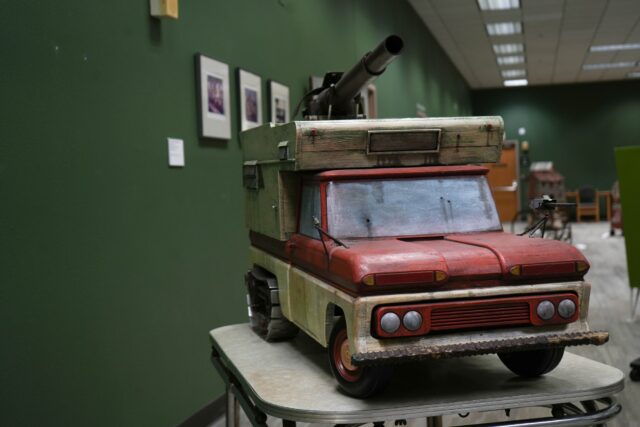By Kalena Reynolds | Staff Writer
Baylor’s Crosshatch Galleries has introduced a new exhibit featuring the works of professor of art Robbie Barber.
Titled “Speaking in the Vernacular,” the exhibit will be in the Jesse H. Jones Library through May. It is the first of its kind to feature three-dimensional pieces, and it includes a wide array of art mediums — from photographs to German wheelbarrows.
All the pieces in the collection are Barber’s personal projects, the oldest being a pickup truck with a gun attached to the top. Barber said it is a “conversation piece” in the exhibit.
“It adds an interesting element to the conversation, so there’s things in the show that have a little bit of an edge to them,” Barber said. “I intentionally try to make pieces that are trying to not give everybody this clear-cut answer. I’d like for them to kind of discover and try and figure out what’s going on here.”
Barber used multiple materials and methods to craft each art piece — from casting metal to constructing out of wood — and he found objects to achieve a “vernacular architecture” look. Barber said he drew inspiration from his hometown of Williamston, N.C.
“In the South where I grew up, they had this house called ‘shotgun shack’ that was a certain kind of style of house that was a [Great Depression] era type house, so that would be considered vernacular architecture,” Barber said. “So my whole show is kind of based on that — when you drive around, drive the country roads of eastern North Carolina, and you see the old houses and the barns and the mobile homes and things like that.”
Barber said a few of his works also draw on political and social problems, but he prefers people interpret the pieces on their own.
“That’s what artists are supposed to do,” Barber said. “We’re not supposed to sit on the sidelines and kind of watch things happen, because we react to what’s happening and give some feedback or points of view. You can not like my work, and you can turn around and want to look at it. Or you can come to see me, and we can talk about it, and then you have a real discussion back and forth.”
Eric Ames, associate director for advancement, exhibits and community engagement, said the exhibit was curated with the intention of bringing an artistic feel that would draw more students into the space.
“It’s a part of our overall goal to put more voices, more color, more visual appeal into the libraries and to really kind of make it a more engaging space all over,” Ames said.
From the beginning conversations about the exhibit, Ames said the Crosshatch Galleries knew it wanted Barber to include three-dimensional pieces that would catch attention.
“With professor Barber, we’ve talked to him all along about really wanting to do a show with 3D pieces,” Ames said. “Moving beyond just pieces hanging on the wall — which are great and stunning and beautiful — but there’s something very special about being able to walk in a circle around a piece or to view it from all different sides.”



